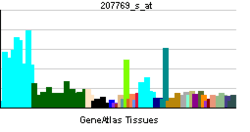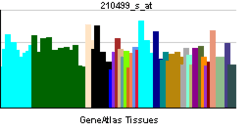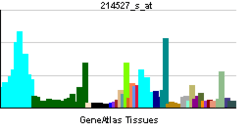PQBP1
| View/Edit Human | View/Edit Mouse |
Polyglutamine-binding protein 1 is a protein that in humans is encoded by the PQBP1 gene.[3][4][5]
Polyglutamine binding protein-1 is a highly conserved nuclear protein expressed in mesodermal and nuclear tissues.[6] The molecular roles of PQBP1 in embryonic development are still being understood, but it has been found to function in mRNA splicing, and transcription regulation.[7] Mutations in the PQBP1 gene, which encodes for this protein, have been known to cause X-linked intellectual disabilities (XLID), commonly referred to as Renpenning's syndrome. People who suffer from these disabilities share a common set of symptoms including: microcephaly, shortened stature and impaired intellectual development.[8] There are 11 types of mutations that have been identified, but the most common being frameshift mutations. A knockdown model of the gene in mouse embryo primary neurons revealed a decrease in splicing efficiency and resulted in abnormal gastrulation and neuralation patterning.[6] Attempts at creating both PQBP1 mouse knockout or over expression models have been unsuccessful, often with lethal results. Research indicates that in order to appropriately function, the protein must be expressed within a critical range.[6]
Function
PQBP1 is a nuclear polyglutamine-binding protein that contains a WW domain (Waragai et al., 1999).[supplied by OMIM][9]
Interactions
PQBP1 has been shown to interact with:
References
- ↑ "Human PubMed Reference:".
- ↑ "Mouse PubMed Reference:".
- ↑ Imafuku I, Waragai M, Takeuchi S, Kanazawa I, Kawabata M, Mouradian MM, Okazawa H (December 1998). "Polar amino acid-rich sequences bind to polyglutamine tracts". Biochemical and Biophysical Research Communications. 253 (1): 16–20. doi:10.1006/bbrc.1998.9725. PMID 9875212.
- ↑ Lenski C, Abidi F, Meindl A, Gibson A, Platzer M, Frank Kooy R, Lubs HA, Stevenson RE, Ramser J, Schwartz CE (April 2004). "Novel truncating mutations in the polyglutamine tract binding protein 1 gene (PQBP1) cause Renpenning syndrome and X-linked mental retardation in another family with microcephaly". American Journal of Human Genetics. 74 (4): 777–80. doi:10.1086/383205. PMC 1181956
 . PMID 15024694.
. PMID 15024694. - 1 2 Waragai M, Lammers CH, Takeuchi S, Imafuku I, Udagawa Y, Kanazawa I, Kawabata M, Mouradian MM, Okazawa H (June 1999). "PQBP-1, a novel polyglutamine tract-binding protein, inhibits transcription activation by Brn-2 and affects cell survival". Human Molecular Genetics. 8 (6): 977–87. doi:10.1093/hmg/8.6.977. PMID 10332029.
- 1 2 3 Iwasaki Y, Thomsen GH (October 2014). "The splicing factor PQBP1 regulates mesodermal and neural development through FGF signaling". Development. 141 (19): 3740–51. doi:10.1242/dev.106658. PMC 4197583
 . PMID 25209246.
. PMID 25209246. - ↑ Mizuguchi M, Obita T, Serita T, Kojima R, Nabeshima Y, Okazawa H (2014-04-30). "Mutations in the PQBP1 gene prevent its interaction with the spliceosomal protein U5-15 kD". Nature Communications. 5: 3822. doi:10.1038/ncomms4822. PMID 24781215.
- ↑ Wang Q, Moore MJ, Adelmant G, Marto JA, Silver PA (March 2013). "PQBP1, a factor linked to intellectual disability, affects alternative splicing associated with neurite outgrowth". Genes & Development. 27 (6): 615–26. doi:10.1101/gad.212308.112. PMC 3613609
 . PMID 23512658.
. PMID 23512658. - ↑ "OMIM: PQBP1 polyglutamine binding protein 1".
- ↑ Okazawa H, Rich T, Chang A, Lin X, Waragai M, Kajikawa M, Enokido Y, Komuro A, Kato S, Shibata M, Hatanaka H, Mouradian MM, Sudol M, Kanazawa I (May 2002). "Interaction between mutant ataxin-1 and PQBP-1 affects transcription and cell death". Neuron. 34 (5): 701–13. doi:10.1016/s0896-6273(02)00697-9. PMID 12062018.
- 1 2 Zhang Y, Lindblom T, Chang A, Sudol M, Sluder AE, Golemis EA (October 2000). "Evidence that dim1 associates with proteins involved in pre-mRNA splicing, and delineation of residues essential for dim1 interactions with hnRNP F and Npw38/PQBP-1". Gene. 257 (1): 33–43. doi:10.1016/s0378-1119(00)00372-3. PMID 11054566.
- ↑ Komuro A, Saeki M, Kato S (December 1999). "Association of two nuclear proteins, Npw38 and NpwBP, via the interaction between the WW domain and a novel proline-rich motif containing glycine and arginine". The Journal of Biological Chemistry. 274 (51): 36513–9. doi:10.1074/jbc.274.51.36513. PMID 10593949.
Further reading
- Fox P, Fox D, Gerrard JW (1981). "X-linked mental retardation: Renpenning revisited". American Journal of Medical Genetics. 7 (4): 491–5. doi:10.1002/ajmg.1320070409. PMID 7211958.
- Stevenson RE, Arena JF, Ouzts E, Gibson A, Shokeir MH, Vnencak-Jones C, Lubs HA, May M, Schwartz CE (May 1998). "Renpenning syndrome maps to Xp11". American Journal of Human Genetics. 62 (5): 1092–101. doi:10.1086/301835. PMC 1377092
 . PMID 9545405.
. PMID 9545405. - Deqaqi SC, N'Guessan M, Forner J, Sbiti A, Beldjord C, Chelly J, Sefiani A, Des Portes V (1998). "A gene for non-specific X-linked mental retardation (MRX55) is located in Xp11". Annales De Génétique. 41 (1): 11–6. PMID 9599645.
- Komuro A, Saeki M, Kato S (May 1999). "Npw38, a novel nuclear protein possessing a WW domain capable of activating basal transcription". Nucleic Acids Research. 27 (9): 1957–65. doi:10.1093/nar/27.9.1957. PMC 148407
 . PMID 10198427.
. PMID 10198427. - Waragai M, Lammers CH, Takeuchi S, Imafuku I, Udagawa Y, Kanazawa I, Kawabata M, Mouradian MM, Okazawa H (June 1999). "PQBP-1, a novel polyglutamine tract-binding protein, inhibits transcription activation by Brn-2 and affects cell survival". Human Molecular Genetics. 8 (6): 977–87. doi:10.1093/hmg/8.6.977. PMID 10332029.
- Komuro A, Saeki M, Kato S (December 1999). "Association of two nuclear proteins, Npw38 and NpwBP, via the interaction between the WW domain and a novel proline-rich motif containing glycine and arginine". The Journal of Biological Chemistry. 274 (51): 36513–9. doi:10.1074/jbc.274.51.36513. PMID 10593949.
- Waragai M, Junn E, Kajikawa M, Takeuchi S, Kanazawa I, Shibata M, Mouradian MM, Okazawa H (July 2000). "PQBP-1/Npw38, a nuclear protein binding to the polyglutamine tract, interacts with U5-15kD/dim1p via the carboxyl-terminal domain". Biochemical and Biophysical Research Communications. 273 (2): 592–5. doi:10.1006/bbrc.2000.2992. PMID 10873650.
- Zhang Y, Lindblom T, Chang A, Sudol M, Sluder AE, Golemis EA (October 2000). "Evidence that dim1 associates with proteins involved in pre-mRNA splicing, and delineation of residues essential for dim1 interactions with hnRNP F and Npw38/PQBP-1". Gene. 257 (1): 33–43. doi:10.1016/S0378-1119(00)00372-3. PMID 11054566.
- Iwamoto K, Huang Y, Ueda S (December 2000). "Genomic organization and alternative transcripts of the human PQBP-1 gene". Gene. 259 (1-2): 69–73. doi:10.1016/S0378-1119(00)00437-6. PMID 11163963.
- Okazawa H, Rich T, Chang A, Lin X, Waragai M, Kajikawa M, Enokido Y, Komuro A, Kato S, Shibata M, Hatanaka H, Mouradian MM, Sudol M, Kanazawa I (May 2002). "Interaction between mutant ataxin-1 and PQBP-1 affects transcription and cell death". Neuron. 34 (5): 701–13. doi:10.1016/S0896-6273(02)00697-9. PMID 12062018.
- Kalscheuer VM, Freude K, Musante L, Jensen LR, Yntema HG, Gécz J, Sefiani A, Hoffmann K, Moser B, Haas S, Gurok U, Haesler S, Aranda B, Nshedjan A, Tzschach A, Hartmann N, Roloff TC, Shoichet S, Hagens O, Tao J, Van Bokhoven H, Turner G, Chelly J, Moraine C, Fryns JP, Nuber U, Hoeltzenbein M, Scharff C, Scherthan H, Lenzner S, Hamel BC, Schweiger S, Ropers HH (December 2003). "Mutations in the polyglutamine binding protein 1 gene cause X-linked mental retardation". Nature Genetics. 35 (4): 313–5. doi:10.1038/ng1264. PMID 14634649.
- Brandenberger R, Wei H, Zhang S, Lei S, Murage J, Fisk GJ, Li Y, Xu C, Fang R, Guegler K, Rao MS, Mandalam R, Lebkowski J, Stanton LW (June 2004). "Transcriptome characterization elucidates signaling networks that control human ES cell growth and differentiation". Nature Biotechnology. 22 (6): 707–16. doi:10.1038/nbt971. PMID 15146197.
- Kleefstra T, Franken CE, Arens YH, Ramakers GJ, Yntema HG, Sistermans EA, Hulsmans CF, Nillesen WN, van Bokhoven H, de Vries BB, Hamel BC (October 2004). "Genotype-phenotype studies in three families with mutations in the polyglutamine-binding protein 1 gene (PQBP1)". Clinical Genetics. 66 (4): 318–26. doi:10.1111/j.1399-0004.2004.00308.x. PMID 15355434.
- Andersen JS, Lam YW, Leung AK, Ong SE, Lyon CE, Lamond AI, Mann M (January 2005). "Nucleolar proteome dynamics". Nature. 433 (7021): 77–83. doi:10.1038/nature03207. PMID 15635413.
- Stevenson RE, Bennett CW, Abidi F, Kleefstra T, Porteous M, Simensen RJ, Lubs HA, Hamel BC, Schwartz CE (May 2005). "Renpenning syndrome comes into focus". American Journal of Medical Genetics Part A. 134 (4): 415–21. doi:10.1002/ajmg.a.30664. PMID 15782410.
- Marubuchi S, Wada Y, Okuda T, Hara Y, Qi ML, Hoshino M, Nakagawa M, Kanazawa I, Okazawa H (November 2005). "Polyglutamine tract-binding protein-1 dysfunction induces cell death of neurons through mitochondrial stress". Journal of Neurochemistry. 95 (3): 858–70. doi:10.1111/j.1471-4159.2005.03405.x. PMID 16104847.
External links
- PQBP1 human gene location in the UCSC Genome Browser.
- PQBP1 human gene details in the UCSC Genome Browser.


